Aldabra Atoll
Isolated in the tropical water of the South Indian Ocean, north of Madagascar and to the east of Africa, the ecosystem of Aldabra is unlike any in the world. The sheer size of the lagoon creates a dynamic with dramatic effects on all of its inhabitants.
The Natural Treasures of Aldabra
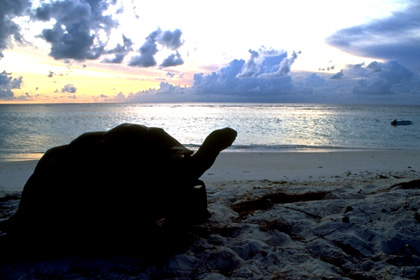 One of the island's elders, a giant land tortoise, sits on a beam of pure white sand and ponders age-old questions as the sun sinks into the South Indian Ocean. Far from any of the 'silk trade' shipping lanes, Aldabra has not been altered from its pristine state. Today the population is still comprised of hundreds of thousands of sea birds, more than 150,000 tortoises, and eight humans.
One of the island's elders, a giant land tortoise, sits on a beam of pure white sand and ponders age-old questions as the sun sinks into the South Indian Ocean. Far from any of the 'silk trade' shipping lanes, Aldabra has not been altered from its pristine state. Today the population is still comprised of hundreds of thousands of sea birds, more than 150,000 tortoises, and eight humans.
Aldabra is the largest coral atoll in the world, and home to an abundance of marine life, both above and below the water. What makes Aldabra Atoll a natural wonder is its enormous inner lagoon that empties and fills twice daily, and its fortunate protection from early marauding traders who saw little of value to plunder.
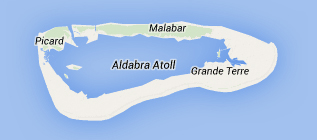 Isolated in the tropical water of the South Indian Ocean, north of Madagascar and to the east of Africa, the ecosystem of Aldabra is unlike any in the world. The sheer size of the lagoon creates a dynamic with dramatic effects on all of its inhabitants.
Isolated in the tropical water of the South Indian Ocean, north of Madagascar and to the east of Africa, the ecosystem of Aldabra is unlike any in the world. The sheer size of the lagoon creates a dynamic with dramatic effects on all of its inhabitants.
The outer reefs, inner lagoon and connecting channels each offer a uniquely different experience. What brings this together is the Fantasea II dive boat, the only access to this wondrous world.
Only recently has the Republic of the Seychelles opened Aldabra for sports diving, with the Fantasea being the only way today to reach this area. A three hour charter flight from Mahe puts the four islands--Aldabra, Astove, Assumption and Cosmoledo--within easy motoring. The other islands are worth visiting, but Aldabra is definitely the gem.
Crystal blue water surrounds the atoll. Schools of curious silver batfish swirl, as divers become part of their ocean refuge. The reefs are filled with huge schools of Yellow-striped Snapper, black Unicorn Surgeon fish, barracuda, gold-lined Sea Bream, and juvenile Sea Goldies. These schools are at times so massive that they appear as swarms of locus that cloud the vistas.
The dive sites are many, mostly unnamed. Murray, our divemaster, finds different conditions and new sealife on repeated dives to the same area. The extreme variability of the tides, and hence the lagoon flow, make each dive a unique adventure
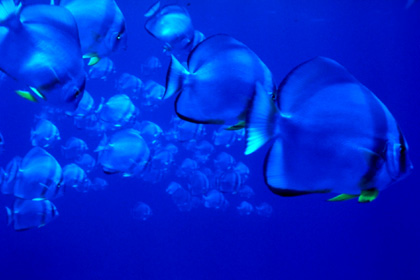 A second world exists within the lagoon. It is so large that you cannot see the other end, and the entire island of Mahe can fit neatly within. The inner edges of the lagoon are ringed with white sand beaches and mangroves. The tangle of mangrove roots provide shelter for those marine creatures swept into the lagoon by the diurnal flow. The land supports a rich mantle of vegetation, which is home to colonies of seabirds and the giant land tortoises.
A second world exists within the lagoon. It is so large that you cannot see the other end, and the entire island of Mahe can fit neatly within. The inner edges of the lagoon are ringed with white sand beaches and mangroves. The tangle of mangrove roots provide shelter for those marine creatures swept into the lagoon by the diurnal flow. The land supports a rich mantle of vegetation, which is home to colonies of seabirds and the giant land tortoises.
Narrow channels connect the rich marine waters which surround the atoll with the inner lagoon. As the lagoon empties, the shallow water becomes alive with fish, sharks, rays and crabs scurrying along the rocks. In the shallow waters of the mangroves, with roots exposed, all the local fish can be found hiding. As the water fills, Picasso Triggerfish, Chinese Grouper, small Javacow Rays and Eagle rays are swept in.
Connecting the ocean waters outside to the quiet waters of the lagoon are four channels: Main, the largest, East, West, and Johnny (named by the French who were the first to settle here). Twice daily, the entire contents of the lagoon are emptied and then filled again. The rapid current causes the waters to boil, and the sediment and nutrients to change the color of the water from crystal blue to emerald green.
The diving excitement never ceased as surprises were always just around the corner of the next reef. On one such dive in the fading afternoon light, we stumbled into a school of Titan Triggerfish. These 'bad boys of the deep' are not to be messed with, as they are known to take a bite out of passing divers. Here in the fading light, we were surrounded by battalions of Titans. On my many diving expeditions, I have occasionally seen one or two of these marauders but never in such great numbers. Their aggressive behavior was so pronounced that normally docile fish were joining in on the attacks.
Lazily adrift on the quiet waters of Aldabra, we wait for our next underwater adventure. The Fantasea II is designed to bring the world of Aldabra within reach in luxury. With its stern sun decks and creature comforts, the time spent awaiting diving is passed relaxing in the warm breezes of the South Indian Ocean.
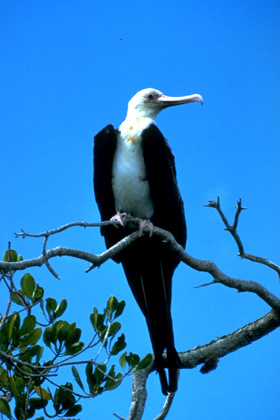 After a lovely morning dive to 115 feet to see a field of gorgonian fans blowing gently in the morning tide, we set off into the East channel to photograph the rare and endangered flightless White-throated Rail. This little bird, which numbers less than a thousand in the world, was very friendly. They came right up to your feet and pecked around.
After a lovely morning dive to 115 feet to see a field of gorgonian fans blowing gently in the morning tide, we set off into the East channel to photograph the rare and endangered flightless White-throated Rail. This little bird, which numbers less than a thousand in the world, was very friendly. They came right up to your feet and pecked around.
The real treasure of Aldabra is the richness of the wildlife experience. We left the Fantasea anchored in deep water and entered through one of the channels. The inner lagoon was alive with colonies of Greater and Lesser Frigatebirds, Tropicbirds, and the Red-footed Booby. Frigates are notorious as 'pirates of the air,' terrorizing Tropicbirds, Boobies and other sea birds, forcing them to drop their catches. Large black clouds of frigates, numbering as many as 27,000, have been seen hovering above the mouth of the lagoon, especially during the breeding season.
Coming ashore on one of the white sand beaches, we split up in search of other Aldabra inhabitants. Aldabra Sacred Ibis and Dimorphic Egrets strut their long legs to search for lunch in the shallows. A large brown Palm Spider sits quietly on its web stretched across the path, waiting for lunch. In the shade of the Causirana trees, large land tortoises wait out the afternoon heat. We spent the rest of the afternoon hand-feeding these gentle creatures succulent green leaves that were just outside their reach.
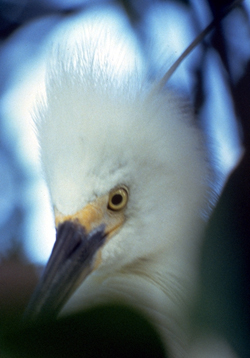 One of the unique Aldabra experiences is the ride on the currents that fill the lagoons. The four major channels provide an opportunity to swim with the big animals that favor the fast-moving waters. The channel drift dive usually brings along sharks, turtles, rays, and the ever-present potato cod. The timing of these dives is critical, for too early or too late, and one has a slow ride. At maximum flow, you risk blowing past the 'catch boat' and being thrashed by the shallow corals.
One of the unique Aldabra experiences is the ride on the currents that fill the lagoons. The four major channels provide an opportunity to swim with the big animals that favor the fast-moving waters. The channel drift dive usually brings along sharks, turtles, rays, and the ever-present potato cod. The timing of these dives is critical, for too early or too late, and one has a slow ride. At maximum flow, you risk blowing past the 'catch boat' and being thrashed by the shallow corals.
As this was to be our second attempt of hitting a fast current (we missed a swift ride two days earlier), Murray built up our excitement promising a roller-coaster thrill. As we readied our gear to drop in all at the same time, the excitement built. Murray yelled '1-2-3 GO!' and we rolled over the side of the rubber Zodiac into the arms of the torrents below.
As we grouped at the bottom, we were surprised by the lack of current. At any moment we expected to be thrust ahead by the funneling channel. Drifting lazily along, we waited and waited.
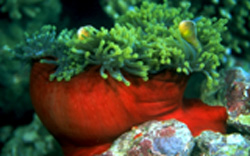 Just as we thought that Murray missed it again, the channel current picked up--but still not enough to give us a really fast ride. Soon the first of the series of six speed bumps, actually hills of sand made by the fast current, appeared. We fanned out to enjoy the first rise and fall as we drifted within inches of the bottom. Captain Wade joined us on this dive, and as he crested the hill, his face glowed with surprise.
Just as we thought that Murray missed it again, the channel current picked up--but still not enough to give us a really fast ride. Soon the first of the series of six speed bumps, actually hills of sand made by the fast current, appeared. We fanned out to enjoy the first rise and fall as we drifted within inches of the bottom. Captain Wade joined us on this dive, and as he crested the hill, his face glowed with surprise.
Skimming along the bottom, we began our assent of the first hill. As we reached the crest, waiting on the other side were 20 large Javacow stingrays resting in the sand. It was hard to determine who was more startled as divers quickly reacted and the school of rays awoke. All of a sudden there were divers and rays everywhere. The meager divers were no match for the rays with all their speed. As the rays scattered, we began speed bump No. 2.
Now the divers were energized, not waiting for the slow current but powering ahead to see what awaited them over the next hill. As we topped the second hill, there appeared three of the largest nurse sharks I had ever seen. Startled by our approach, they too scattered, their six foot bodies flexing to let the divers pass. As we started to suck the air from our tanks, we anticipated the next hill. Before we reached the top, we spied another large nurse shark with its head firmly planted in a hole in the rock. We stopped briefly to pet its tail which brought little response as the shark continued its afternoon nap.
Over the next hill we found a large sleeping green turtle unaware of our approach. As we gently swam over, he awoke, but we had enough time to say hello with a friendly pet on his head and shell. Four three foot Blacktip sharks appeared more aware of our approach--and not too happy. They came to life and began to circle the group with their anger up. Their body language was clear that they did not like the rude awakening.
Over the next hill the rays were back, but this time they were accompanied by large nurse sharks and turtles. It was pandemonium: divers, rays, sharks and turtles scurried in every possible direction at the same time. As we regrouped and tried to catch our breath, there appeared a pair of Spotted Eagle rays in the company of more turtles.
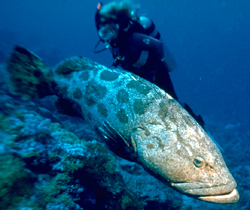 We forgot about the lack of current as we all were racing ahead to see what was next. Meanwhile, Potato Cods too numerous to count were perched along the walls of the channel as if they were seated in some large amphitheater, watching the main event unfolding below. As the channel emptied into the lagoon, we were bid farewell by a solitary Great Barracuda wondering what all the excitement was about.
We forgot about the lack of current as we all were racing ahead to see what was next. Meanwhile, Potato Cods too numerous to count were perched along the walls of the channel as if they were seated in some large amphitheater, watching the main event unfolding below. As the channel emptied into the lagoon, we were bid farewell by a solitary Great Barracuda wondering what all the excitement was about.
The channels of Aldabra provide the lagoon and surrounding water with a natural environment unlike any in the world. Many of the sealife and water fowl are unique to this area rich in food supplies. Surfing the channels of Aldabra is not to be missed, for along with the flow of nutrients and fish are the big pelagics. Each drift brings with it new surprises and the thrill of being a part of this natural process.
All of this beauty and adventure is made possible by the Fantasea II live-aboard and its able crew. There is no lodging available on Aldabra, and its frail environment is strictly protected as a World Heritage Site by the Republic of the Seychelles. The crew of the Fantasea are among the first to identify the pockets off-shore and in the lagoon where natural resources are the richest.
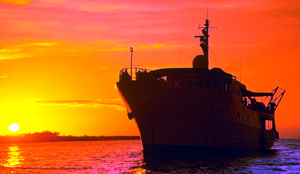 After a full day of diving and island adventures, the Fantasea provides a floating home where we relax in the setting sun and enjoy the warm breezes of the Indian Ocean. Under a brilliant sky, we dine on gourmet Mediterranean cuisine, discussing our day's adventures with our new-found friends. How fortunate we are to be part of the few who have experienced the many natural treasures of Aldabra.
After a full day of diving and island adventures, the Fantasea provides a floating home where we relax in the setting sun and enjoy the warm breezes of the Indian Ocean. Under a brilliant sky, we dine on gourmet Mediterranean cuisine, discussing our day's adventures with our new-found friends. How fortunate we are to be part of the few who have experienced the many natural treasures of Aldabra.
There is little doubt that Aldabra is the best of the last vestiges of the natural world. Our special trips to the inner lagoon were definitely the highlight of the Aldabra experience. What brought us to this coral atoll in the South Indian Ocean was diving. What we discovered was an adventure and an experience never imagined.
